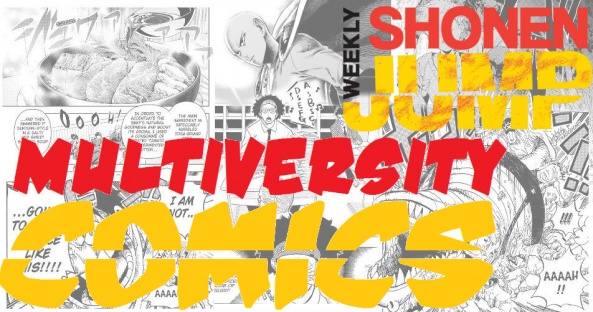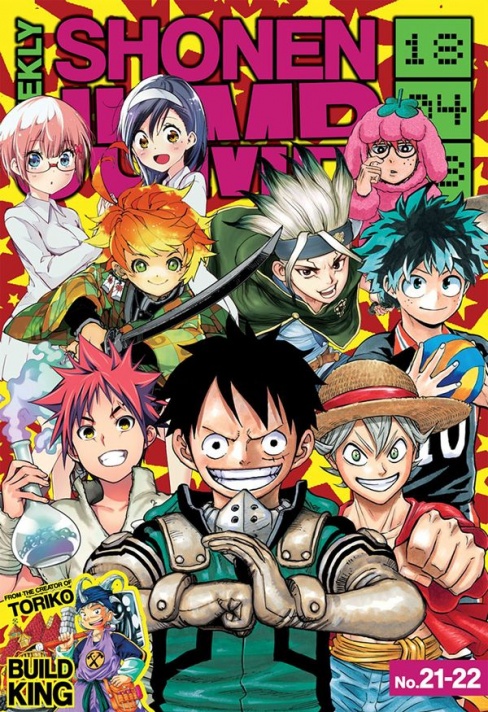
Welcome to This Week in Shonen Jump, in which a rotating duo of Multiversity staffers take a look at two stories contained in each installment of Viz Media’s Weekly Shonen Jump. For the uninitiated, Weekly Shonen Jump is an anthology that delivers more than 200 pages of manga of all varieties. We hope that you’ll join us in exploring the world of Weekly Shonen Jump each week. If you are unfamiliar, you can read sample chapters and subscribe at Viz.com.

This week, Zach and Vince check in with “Black Clover” and “Build King.” If you have any thoughts on these titles, or “One Piece,” “We Never Learn,” “The Promised Neverland,” “Yu-Gi-Oh Arc V,” “Robot X Laserbeam,” “Dr. Stone,” “Food Wars,” or “My Hero Academia,” let us know in the comments!

Black Clover Chapter 154
Written and Illustrated by Yuki Tabata
Reviewed by Zach Wilkerson
Pitting once friendly heroes against each other is a common trope of American super hero comics, and is one that “Black Clover” utilizes well in it’s latest arc. By rounding up the cream of the crop under the banner of Royal Knights and then splitting the field through the “elf resurrection” development, Tabata creates a compelling conflict for Asta and his remaining companions to overcome. However, this chapter also highlights the lack of development among the book’s second and third string cast.
After last week’s particularly fun and humorous victory for Asta, chapter #154 feels a good deal lighter. Somewhat disappointingly, Asta separates from his interesting new companions to return to more familiar cast members Mimosa and Yuno. Part of this is done in service of amping up the stakes, but it’s nevertheless sad to see the immensely enjoyable Zora and Mereoleona pushed to sidelines. Zora in particular is one of the few newer characters to receive a fair amount of character background and growth. The decision to shift away is a big part of my misgivings with this chapter.
Before I go there, however, a high note. Artistically, the book is stronger than ever. Tabata’s use of lighter lines, minimal inking, and unique shading to convey the difference of the elven characters is a nice touch. Furthermore, his depiction of these high level magic abilities is a visual delight.
The biggest development of the week regards Mimosa and Yuno. Mimosa is now a captive of the resurrected elves, among whose company is the possessed Yuno. On one hand, the revelation that such a high profile character is among the elves lends a sense of urgency that previous chapters have failed to convey. This is due, mostly to the lack of development among the rest of the Royal Knight characters. It’s hard to empathize with Mimosa’s pain and betrayal here because we just don’t have much of a connection to either Klaus or Harmon. It works on a conceptual level, but on an emotional level it falls flat. The final moment, hinging on Yuno and Asta’s Wizard King rivalry is simultaneously exciting in its execution and frustrating in its predictability. Even Yuno, technically a “main” character, has yet to develop far beyond Asta’s prodigiously talented rival. His ability to break through his elven state is less exciting because of this.
Ultimately, this is a fairly standard pivot chapter that capitalizes on well worn story tropes. Nevertheless, these developments manage to elevate the stakes for this arc and push the plot onto the next major battle.
Final Verdict: 6.0 – As usual, “Black Clover” is visually remarkable but the actual plot leaves something to be desired.

Written & Illustrated by Mitsutoshi Shimabukuro
Review by Vince J Ostrowski
When one thinks of “shonen manga” they probably think of one of the famous long-running series like “Dragon Ball” or “Naruto”, even though the term is a description of the genre rather than the form it’s delivered in. Perhaps part of the reason that manga is thought of in this way is that there just aren’t very many opportunities to get one complete story from a property in a periodical magazine like “Weekly Shonen Jump”, which is usually just comprised of short chapters of a larger running narrative that is usually impenetrable without at least a surface level understanding of the story so far, or at least the most recent major events. Easy opportunities to sell someone on briefly checking out manga through the long-running magazine don’t come along often, which is why I wanted to talk about “Build King” this week. “Build King” is a manga about a master builder, with special tools and even more special skills for building structures with speed and ease, and that simple premise is all anyone needs to know to jump in.
Continued belowWhat’s great about the journey that the reader takes through “Build King” is that it features many of the core aspects of shonen manga over its short page count, and excels at almost all of them. There’s a plucky hero (Kugi) who is both amazingly talented but also thick enough in the head that it feels like he’s still an underdog. There’s the magical house support character, which gives the reader the fantastical anthropomorphic element as well as a comedic foil for the hero to bounce off of. This part wears a little thin, as the back and forth banter between the boy and his house goes from featuring chuckle-worthy house puns to grating arguments that wear out there welcome. In short order, this back-and-forth becomes insanely annoying. In my experience reading “Build King”, this was the only weak aspect and it took up precious little page time. In the typical shonen tradition, a couple of sub-villains are introduced, which eventually gives way to a big boss character. All along the way, the surprises of “Build King” reveal themselves like layers of an onion. I don’t mean to imply that “Build King” is deep in any sort of philosophical sense, but that in just over 50 pages, it accomplishes the same levels of escalation in scope and stakes that longer running manga build over many chapters. Kugi begins his journey where all manga heroes begin: demonstrating his skills on a small scale, but one that shows the reader that he’s better than average at those skills. To begin, he builds a human-sized birdhouse for a massive parakeet in less than 30 minutes with some dynamic hammering. I wouldn’t be able to build a normal-sized birdhouse in less than 3 hours, probably, and it would look like absolute garbage. Within a few pages, you’re introduced to the magical talking house, which then begins to unravel its own secret skills. I won’t ruin the big surprises, which become absolutely bonkers by the end of the story, but I will say that the first fight involving Kugi and his house versus a couple of petty thieves features some Home Alone-style traps and pitfalls. And that sequence is only the beginning, because by the end the heroes are leveling up and showing off new powers in ways that only a shonen manga can provide.
Shimabukuro’s art is vintage shonen stuff, with a flair for dynamic action and the ability to convey a lot of very specific aspects of house-building and convert them into shonen fighting moves and magical abilities. “Build King” is like a little study in building as a hobby, but applied to shonen storytelling in appropriately cartoonish fashion. The issue opens on a short sequence of Kugi hammering a massive nail with a humongous hammer to finish a birdhouse. It’s immediate evidence that the manga-ka understand the essential absurdity of shonen manga. Why bother doing a manga about a building savant and not draw the hammer and nail as big as possible? Shonen manga is supposed to upgrade the mundane into being the stuff of legends. Mitsutoshi Shimabukuro just gets it. Further evidence of the artist’s intent is in the design-work. Kugi is drawn as a plucky young boy, not unlike Son Goku in the earliest installments of “Dragon Ball.” He’s even essentially wearing Goku’s gi, with a pair of crossed hammers in place of Goku’s classic kanji emblem. The chugging, rumbling, talking house takes more than a few cues from manga and anime history, but to reveal what some of the later “upgrades” to the house call to mind would be to give away “Build King’s” best secrets. Most important to a shonen manga is the way a fight scene is handled, and again “Build King” is no slouch. Let’s return to the “Home Alone” scene I mentioned earlier: As the thieves attempt to breach the house’s door, they’re delivered a smack that sends them flying across the page. Shimabukuro understands the necessary comedic and weighty balance of selling a sequence like this. A magical door swinging out and hitting the oafish thief in the face is made much funnier when the thief’s eyes bug out of his head, but the impact is felt too as the enemy skids along the ground seemingly being thrown a few dozen feet from the house’s threshold. A panel later, he’s right back in the fray again. If pure entertainment is the goal of a particular shonen manga (and with “Build King” it clearly is), then it should be big and goofy and wear its heart on its sleeve while disregarding physics at all costs. We should see big punches landed, massive increases in scale, and sound effects popping everywhere. “Build King” delivers the goods and doesn’t let up for a second.
Final Verdict: 8.5 – “Build King” is an incredibly charming one-shot story and a wonderful exercise in extreme levels of escalation, one of shonen manga’s most timeless traditions, all over the course of one short installment.






